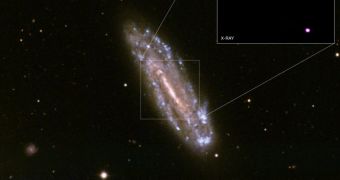NASA's Chandra X-ray observatory has detected what may be the smallest supermassive black hole ever discovered.
The space telescope found the X-ray source at the center of a bulgeless spiral galaxy, which is normally not expected to harbor a supermassive black hole at its center.
The discovery challenges the notion that a central bulge, a greater density of stars and star dust, is needed for a supermassive black hole.
It may also indicate that there may be a new type of supermassive black hole, which possibly shares the same creation method, but is smaller than what is categorized as being a supermassive black hole, alternatively, that supermassive black holes can be smaller than previously believed.
The X-ray source was discovered at the center of the NGC 4178 spiral galaxy. Analysis has shown it to be a supermassive black hole that is actively feeding, but a very small one at less than 200,000 solar masses.
Supermassive black holes are expected to have between millions to billions of times the mass of the sun.
Four other galaxies without central bulges are believed to have supermassive black holes at their center. Only two of those may have a mass similar to the black hole at the center of NGC 4178.
The NGC 4178 black hole is actively feeding, but little light escapes the region, suggesting that it's surrounded by dense dust and gas clouds. Astronomers were able to detect light in the infrared spectrum, at several points, besides the X-ray emissions.
As you can see from the image provided by the researchers, there are three other X-ray sources in the galaxy. Two of them are powerful enough to place them between an X-ray binary and an ultra-luminous X-ray source (ULX).
The third is even brighter, brighter than the active galactic center even, which puts it firmly into ULX territory. There are several hypotheses which explain ULX sources, which are too bright to be generated by stellar mass objects, black holes or otherwise.

 14 DAY TRIAL //
14 DAY TRIAL //